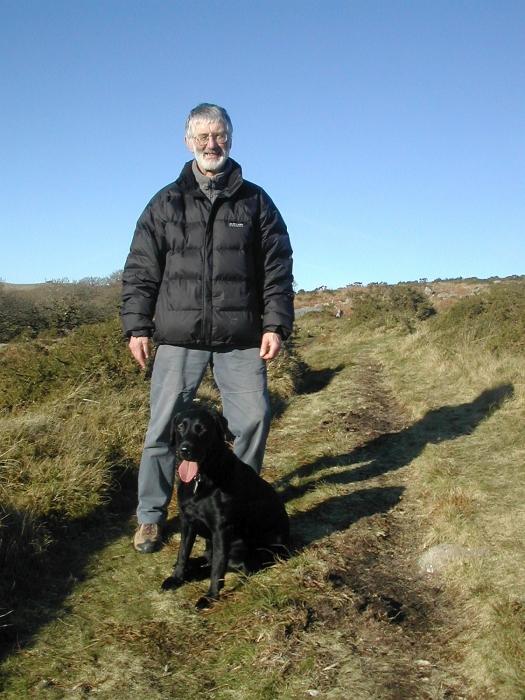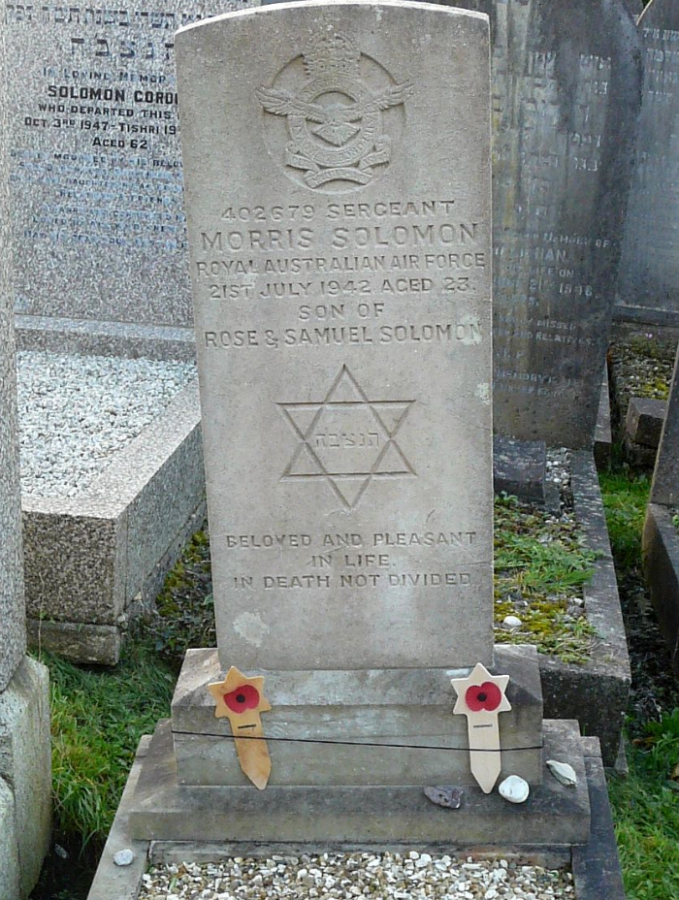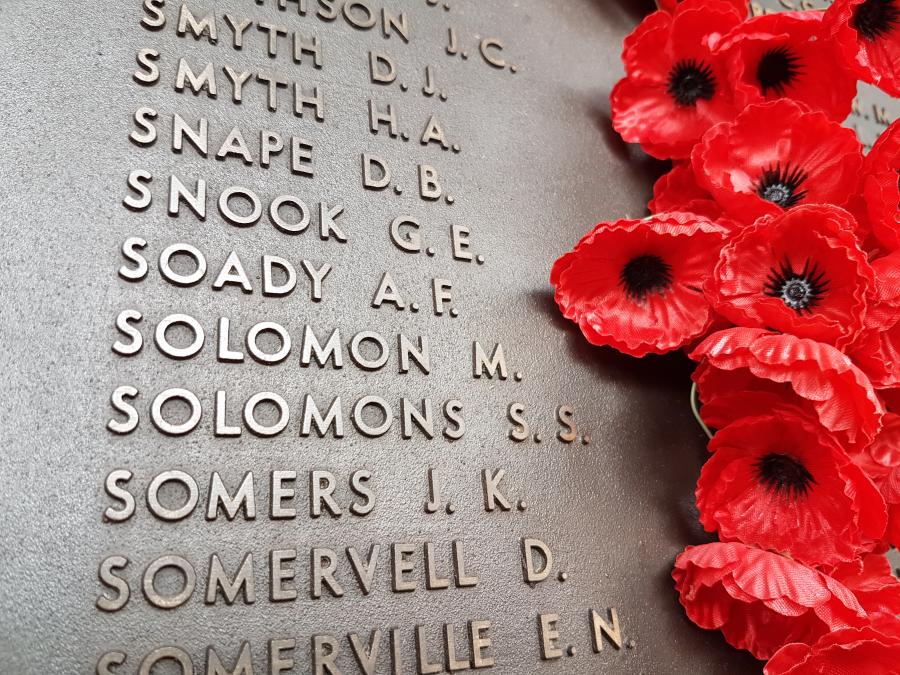'It was a pleasure to attempt to honour his memory'

Sergeant Morris Solomon: "He was ‘Uncle Morrie’ rather than Morris."
For almost 30 years, Englishman Raymond Batkin has been carefully tending the grave of a lone Australian airman at a Jewish cemetery in Britain.
“It seemed the right thing to do,” Raymond said from his home in Plymouth. “I started to visit the grave on, at least, an annual basis from the mid-1980s, usually on the date of his death and then again just before Remembrance Sunday each November.
“I leave a Remembrance Star [of David] on the grave along with a pebble or stone, which is customary in visiting a grave of a [Jewish] friend or family member.”
Raymond first noticed the grave after he and his young family moved to Plymouth in the late 1970s, but he never dreamt his visits to the local Jewish cemetery would set him on a journey of discovery.
“I grew up with many Jewish friends in London [so] I visited the Plymouth Synagogue as a matter of course soon after we arrived in Plymouth, and I got to know the Rabbi, Dr Bernard Susser,” Raymond said.
“I have an interest in military history … and he mentioned the military graves at the Jewish cemetery which is close to my home. On the first visit I noticed the grave of Morris Solomon, which was particularly distinctive as the headstone bore the RAAF insignia…
“After almost 30 years since I first ‘met’ Morris at the Jewish Cemetery and the many visits I have made to his grave since, [it] has left its mark on me. The curiosity about him being so far away from his home country, Australia, and whether he had any surviving family never went away.
“Placing a Remembrance Star of David poppy on his grave each November began to seem inadequate. The start of a series of public commemorations to mark the beginning of the First World War was a catalyst to ‘stop thinking and start doing’.”
Raymond used the information on Solomon’s headstone to start his research, trawling through online military archives and records in Australia and Britain in a bid to learn more about this young Australian.
The eldest son of Samuel and Rose Solomon of Double Bay in Sydney, Morris Solomon enlisted in 1940, shortly after turning 21. He served with the Royal Air Force as part of the 1404 Meteorological Flight, flying daily meteorological reconnaissance off the south-west coast of England. As other flying operations depended on their weather reports, the crew had to operate in practically all weathers. It was sometimes said that they would operate when “even the birds were walking”.
On the 21st of July 1942, the Lockheed Hudson in which Solomon was a crew member was returning to base when it encountered low cloud and was unable to land. Directed to land further south, the pilot instead followed the coast northwards, flying at low altitude. While still in cloud, the aircraft crashed into the cliffs at Kellan Head. All four crewmembers were killed, including Sergeant Solomon, who had just turned 23.

Raymond Batkin: "The curiosity about him being so far away from his home country, Australia, and whether he had any surviving family never went away."
Eventually, Raymond’s research led to contact with Solomon’s family.
“A friend of mine in Israel had links to the Australian Jewish Community and knew Rabbi David Freedman [in Sydney]. That led to a chance meeting by Rabbi Freedman with Judith Eisner. The rest, as they say, is history.”
Judith Eisner was in Sydney for a Remembrance service for her Uncle David – Morris’s younger brother – when she met Rabbi Freedman, who had been trying to find Morris’s family on Raymond’s behalf.
“His jaw dropped,” Judith said. “He’d buried my mum a few years earlier and he was a friend of my son and my daughter-in-law. He was like, ‘Of course, your mother was a Solomon.’ He gave me Raymond’s email and that is how this relationship started a few years ago … I just find it’s just so special to have that contact, it’s brought my uncle, the uncle that I didn’t know, back into my life.”
Morris Solomon, who died two years before Judith was born, was remembered in a Last Post Ceremony at the Australian War Memorial on 3 December.
“He was two years younger than my mother, and he was ‘Uncle Morrie’ rather than Morris,” Judith said. “The photograph was always there in my grandmother’s house. He was always with us … He was a fine young man, but I learnt more from Raymond and his biography of him … It must have been horrendous for my grandparents [when he died], I’m sure, like it was for all families in wartime … In those days people didn’t talk much about it, and I just remember the loss and the love. I think there was such a lot of loss at the end of the war that people tended to keep it close to them.”
Raymond’s kindness in tending Morris’s grave has meant the world to Judith and her family.
“It’s been such a lovely connection,” said Judith, who lives in Canberra. “Raymond’s just one of those lovely people in the world. He saw this man had died and had given his life in the war effort. He’s a lovely man who has done a lovely deed. He visits every Memorial Day and looks after the grave. It’s so lovely, so heart-warming that he does this just because he sees this man is so far from home. It’s brought my connection with my uncle that I didn’t know alive.”
Seventy-five years after Morris’s death, Judith and her family lay a wreath at a Last Post Ceremony commemorating his life. “My uncle’s name is one of the thousands on that wall [at the Memorial], and it’s a lovely way of honouring him,” she said.
Raymond got up in the early hours of the morning to watch the ceremony live over the internet from his home in Plymouth. “I do not regard my researching of Morris Solomon’s story as anything more than a mitzvah [or kind deed],” Raymond said. “I would like to think we would have got on well together and become friends had we actually met and lived in the same times … It was a pleasure to attempt to honour his memory.”

